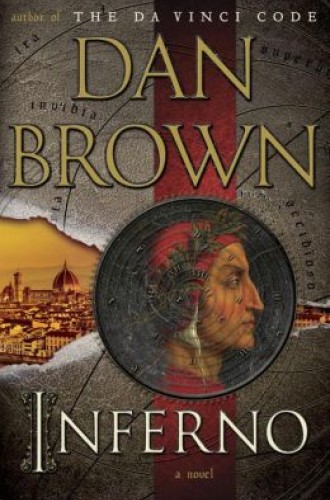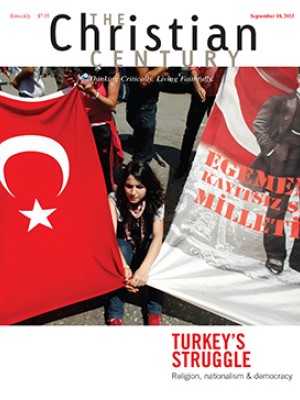Travels with Dan Brown
In the opening pages of his 2003 blockbuster The Da Vinci Code, Dan Brown famously contends that “all descriptions of artwork, architecture, documents, and secret rituals in this novel are accurate.” A decade later, a similarly ludicrous claim to historical accuracy appears on the first page of Inferno. He writes: “Fact: All artwork, literature, science, and historical references in this novel are real.” I find the use of the word fact particularly charming.
What should we make of such insistence as the lead salvo in a work of fiction? It is both immediately irresistible and patently absurd. Fact: I’m powerless to say precisely what he means by it—or why he would make such a disingenuous remark. Imagine a narrator stating at the beginning of an Edgar Allan Poe tale: “Fact: Everything you are about to read is true.”
Read our latest issue or browse back issues.
For features like this, Brown has been the butt of some of the most deliciously funny jibes ever produced by fellow novelists. Stephen King said that Brown’s work was the “intellectual equivalent of Kraft macaroni and cheese,” and Salman Rushdie called The Da Vinci Code “a novel so bad it gives bad novels a bad name.” Clive James, a poet and a translator of Dante (a key figure in Brown’s Inferno), offered this tongue-in-cheek assessment: “I have a great belief in Dan Brown’s attractions as a writer. The belief is all the greater because I can’t quite define what those attractions are. Certainly they don’t have anything to do with his prose, which would be unreadable if it were not so riveting.”
I admit that I have the same sort of love-hate relationship with Brown’s prose. It is repetitive, materialistic and digressive, and he often uses italics for no apparent reason. It is hard to explain his record-breaking popularity. The New Yorker comments: “The dialogue is dead. As for the rest of the writing, it is not dead or alive. It has no distinction whatsoever.”
But tens of millions of readers—like me—haven’t been able to put Brown’s books down. In the first week after its release, Inferno rang up a whopping 228,961 copies sold in the United Kingdom, and in the United States as of this writing, 4 million copies have already been shipped. And that’s peanuts in the career of Dan Brown. His previous five novels sold over 190 million copies altogether, making him a billionaire novelist.
The plot of Inferno is fairly simple. As in The Da Vinci Code, the hero is Harvard symbologist Robert Langdon. The story revolves around Dante’s death mask, which reveals how his Divine Comedy is coded into priceless Renaissance paintings and other relics. Langdon deciphers codes that reveal the location of a hidden plague that European billionaire Bertrand Zobrist designed to cull the population of Earth by rendering people sterile.
As Zobrist, a sort of genetics-genius Swiss Bill Gates, races to downsize humanity, black-leather-attired Germans chase after Langdon and his quirky, brilliant and sexy female assistant Sienna (but wait!—is she really who she says she is?), and a huge luxury yacht lurks offshore in the Adriatic, creating illusions of power and wealth. What’s not to like?
But I have to wonder: Why would a terrorist leave elaborate clues to his own mad plots? If you’ve decided to pull the trigger, then why leave detailed codes that some Ivy League egghead might be able to break, thus foiling your crazy scheme? Nearly every page of the novel prompts questions like this. Readers seem to find the implausibility of Brown’s major and minor plot devices pleasurable, for whatever reasons.
The novel’s settings, including the art and architecture, may be the best part. Brown is like the Rick Steves of novelists: he’s quite skilled at evoking the beauty of a city or church or palace. Although Brown gets dissed for his many travelogue inserts, those are often my favorite parts. He makes me want to go back to Florence and Venice; he recalls for me my own wonder and awe at Florence’s Duomo and Venice’s Doge’s Palace. And I now look forward to wandering through the Spice Bazaar of Istanbul.
The book would be half as long if a good editor tore into some of this travel detail (not to mention the vast amount of repetition, often in italics), but I think it’s fair to say that Langdon’s bourgeois tastes are as intoxicating as the jet-hopping to exotic locales—locales that Brown evidently knows inside and out. Whenever he says that Langdon stopped at this or that coffee bar, or that Langdon far preferred this museum or painting to that one, or that such and such was by far Langdon’s favorite street or park in all of Tuscany, I know it’s really Brown speaking for himself. But I do make a mental note. It’s the good life, albeit in Langdon’s tweed jacket and Mickey Mouse watch.
So Brown is an easy target. And yet, as a purveyor of ideologies Brown is endlessly fascinating. For instance, in Inferno the concepts of the “posthuman” and “transhumanism” are crucial (though typically presented in a cartoonish way). The novel invites readers to ask: Where are we going as a race? How must we confront the coming environmental disaster (evidently a given in Brown’s universe)? How can technology enhance our abilities as humans, and how is it destructive to our humanity?
Brown’s portrayal of the future, mainly through the mad scientist Zobrist, is very threatening and scary. Or is it? I ask, because it’s hard to tell where Brown wants to take us with regard to transhumanism. His account of environmental apocalypse is plausible, if somewhat hysterical: he urges us to recognize that this threat is looming and truly frightening. Environmental apocalypticism has been one of the major themes in American literature for some time now, especially in science fiction novels, graphic novels and films.
Near the end of Inferno one of the main characters exclaims, “This all feels like science fiction to me.” In fact, Inferno can be analyzed as a variation of popular science fiction because it places before the reader important issues about the uses of science and technology in the present and in the future, and it forecasts where such technologies might take us morally and ethically.
Brown leaves the distinct impression that he largely agrees with the transhumanist philosophy motivating Zobrist’s whacked-out methods. Perhaps our planet is facing environmental disasters beyond our imaginations. Perhaps we’ve all been lulled into a deep sleep, thinking that our attempts at creating a greener world will somehow solve the problems of massive overpopulation, compounded by the decreasing availability of food, water and fuel for the vast majority of humanity. Perhaps we’ve even allowed science to capture our hearts as a savior and protector, in place of a benevolent God. Inferno may not be great literature like that classic from more than 80 years ago—Brave New World—but it certainly resonates with the themes of Aldous Huxley’s elegant masterpiece. Unlike Huxley, however, Brown may be sympathetic to the wrong character.
In our post-9/11 world, laced with all sorts of terror plots and covert madness, perhaps there is something darkly plausible about a bioterrorism scheme such as the one that unfolds in Inferno. The questions Brown asks in the book are worth thinking about. What is the nature of humanity, and where is humanity headed? To what extent do genetic manipulation and human interactions with computers and other machinery change human nature? And what are we going to do, as a civilization, about the 2 or 3 billion humans now forced to live on less food and water than Westerners can even imagine?
In one interview, Brown said: “I always try to choose the gray area and argue both sides. If I’ve done my job, you close this book saying ‘Oh my God, what an enormous problem, and there is no simple solution, and I kind of see Zobrist’s point.’” So if you feel even more squeamish about the future after reading Inferno, staring into the abyss of apocalypse, evidently it’s by design.






